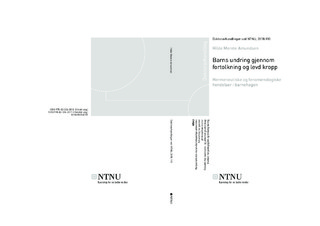| dc.contributor.advisor | Steinsholt, Kjetil | |
| dc.contributor.author | Amundsen, Hilde Merete | |
| dc.date.accessioned | 2018-09-13T10:47:54Z | |
| dc.date.available | 2018-09-13T10:47:54Z | |
| dc.date.issued | 2018 | |
| dc.identifier.isbn | 978-82-326-3011-0 | |
| dc.identifier.issn | 1503-8181 | |
| dc.identifier.uri | http://hdl.handle.net/11250/2562478 | |
| dc.description.abstract | Denne avhandlingen er et bidrag til det barnehagepedagogiske kunnskapsfeltet og har som mål å utvikle en ny forståelse for barns livsverden (den førteoretiske verden som er selvinnlysende eller gitt) og barns danningsprosesser i barnehagen. Avhandlingen belyser barnets eksistens som homo admirans (det undrende barnet) og homo interpretans (det fortolkende barnet), og er basert på en hermeneutisk-fenomenologisk studie som vektlegger barns levde erfaringer. Gjennom å understreke barns undring og fortolkning som overordnede livsuttrykk og manifestasjoner på livet og som betydningsfulle i deres danningsprosesser, stiller avhandlingen spørsmålet: På hvilke måter viser undring og fortolkning seg som barnlig fenomen i barnehagen?
Avhandlingens teoretiske rammeverk er basert i filosofi, nærmere bestemt Hans-Georg Gadamers filosofiske hermeneutikk og Maurice Merleau-Pontys kroppsfenomenologi. Sentralt i forståelsen av barns undring og fortolkning er Gadamers generelle teori om forståelse. Ulike kjernebegreper i hans filosofi utdypes for å forstå fenomenet under utforsking; dialog, erfaring, sannhet, applikasjon, lek, vennskap, theoría, fronesis og danning. Merleau-Pontys fenomenologi om persepsjonens forrang og kroppen som forståelsens sted er essensiell for å forstå kroppens betydning i barns undring og fortolkning. Avhandlingen utdyper sentrale begreper i hans filosofi som persepsjon, legemliggjort subjektivitet, kropps-subjektet, ‘kjød, kiasme, reversibilitet, écart og ekspressiv kognisjon; begreper som anvendes i en forståelse av barnekroppen selv som kognitiv og ekspressiv.
De empiriske data er basert på levd observasjon (inklusive video-observasjon, lydopptak og fotografi) i en barnehage i to barnegrupper, hver med barn i alderen tre til seks år, i en periode på seks måneder.
Studiens viktigste empiriske funn er at barns undring og fortolkning viser seg som en særegen barnlig ekspressiv dialogisk måte å være-i-verden på, som en sammenfletning mellom vennskapelige samtaler, fortellinger, lek, fest, poetikk og kroppslige uttrykk, ‘språk’ som overlapper hverandre og ofte er samtidige. Oppsummert viser fenomenet seg som legemliggjort kommunikasjon om verden, en fortolkningspraksis der verden skjenkes mening. | nb_NO |
| dc.description.abstract | This thesis is a contribution to the pedagogical field of knowledge concerning the kindergarten. The objective of the thesis is to bring about a new understanding of children’s lifeworld (the pre-theoretical world of what is self-evident or given) and their formative development. The thesis highlights the child’s existence as Homo Admirans (Child the wonderer) and Homo Interpretans (Child the interpreter) and is based upon a hermeneutical-phenomenological study that emphasizes children’s lived experiences. In stressing children’s wonder and interpretation as superior life-expressions and manifestations of life essential to their formative development, this thesis examines: In what ways do wonder and interpretation show itself as a childlike phenomenon in kindergarten?
The theoretical framework of the dissertation is based on philosophy, respectively Hans-Georg Gadamer’s philosophical hermeneutics and Maurice Merleau-Ponty’s phenomenology of the body. Central to the understanding of children’s wonder and interpretation is Gadamer’s general theory of understanding. Several core concepts of his philosophy are elaborated; dialogue, experience, truth, application, play, friendship, theoría, phronesis and formation, in order to understand the phenomenon of investigation. Merleau-Ponty’s phenomenology on the primacy of perception and the body as the location of understanding is essential to the understanding of the significance of the body in children’s wonder and interpretation. The dissertation elaborates central concepts in his philosophy such as perception, incarnate subjectivity, the body-subject, ‘flesh’, chiasm, reversibility, écart, and expressive cognition, concepts that are applied in an understanding of the child’s body itself as cognitive and expressive.
The empirical data is based upon lived observations (including video-observations, sound recording and photography) in one kindergarten, in two groups of children, each consisting of eighteen children aged three to six years old, during a period of six months.
The study’s most important empirical findings are that children’s wonder and interpretation shows itself as a peculiar childlike expressive dialogic way of being-in-the-world, as an interwining of friendly conversations, narratives, play, feast, poetics and bodily expressions; ‘languages’ that overlap and often are concurrent. In sum the phenomenon shows itself as incarnate communication about the world, an interpretive praxis where the world is granted meaning. | nb_NO |
| dc.language.iso | nob | nb_NO |
| dc.publisher | NTNU | nb_NO |
| dc.relation.ispartofseries | Doktoravhandlinger ved NTNU;2018:110 | |
| dc.title | Barns undring gjennom fortolkning og levd kropp. Hermeneutiske og fenomenologiske hendelser i barnehagen | nb_NO |
| dc.type | Doctoral thesis | nb_NO |
| dc.subject.nsi | VDP::Samfunnsvitenskap: 200::Pedagogiske fag: 280 | nb_NO |
